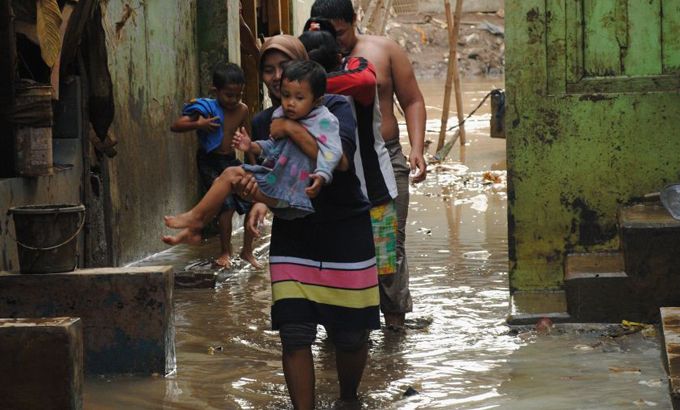
Stemming the tide
Can Jakarta ever root out the problems that cause so much destruction after every monsoon season?
Jakarta, Indonesia, is one of Asia’s most flood-prone cities. Every year hundreds of thousands of citizens living in the capital of Southeast Asia’s largest economy brace for the loss of business, shelter and livelihoods.
Each year, as the rainy season approaches, the authorities insist they are ready to counter the tides of brown murky water, trash, and even animals, surging downstream. But the annual city-wide submergence continues.
Keep reading
list of 4 itemsWorld’s coral reefs face global bleaching crisis
Why is Germany maintaining economic ties with China?
Australia’s Great Barrier Reef suffers worst bleaching on record
This year’s sustained downpour threatens to prompt the kind of flooding not seen since 2007 when 350,000 people were evacuated from water-logged areas and dozens were killed. Already, at least 100,000 people have been affected. Army personnel have been deployed to some of the city’s poorest parts to clean up – a process likely to take weeks, if not months.
Asia’s monsoon season prompts annual debate about the state of infrastructure and the fundamental mismanagement of vital systems meant to keep some of the world’s biggest cities moving. With a population of 10 million, Jakarta’s latest battle to stem the tide highlights a deeper political and social problem: The government’s inability to remove and rehabilitate low-lying slum areas; an unwillingness on part of thousands of poor people to leave dangerous areas despite the risk to themselves and their families; and the overwhelming problem of waste and dumping, often cited as the biggest hindrance to keeping Indonesia “flood-free”.
Indonesia faces a formidable challenge: The country’s economy is growing at breakneck speed, its population is rising and the pressures on its decaying systems are mounting. The World Bank has stepped in to help save what it describes as a “sinking city”, due to rising sea levels, trash and annual rain. To dig the city out of its mess, the World Bank has invested $200 million to dredge parts of Jakarta.
But is one programme at a time, one initiative every season, enough to solve the deluge of problems?
101 East explores why the authorities find it so difficult to keep the surging waters at bay. We follow the stories of Indonesians who lose their homes and their livelihoods year after year, the businesses that damage control annually in vain, and the agencies and people who say they work tirelessly year round only to see one of the world’s most densely populated cities “go under” without a fight.
We investigate what makes the rainy season so dangerous in the capital of Southeast Asia’s fastest growing economy, and if it can ever stem the tide of destruction.
| Filmmaker’s view |
By Nidhi Dutt
Every year Jakarta and its 10 million citizens brace for the rainy season.
Every year the local government insists the city’s flood defences are in place and they are well prepared to handle months of heavy rain and all that comes with it.
But despite these assurances, every year low-lying and coastal areas across Jakarta are choked with torrents of brown, murky water.
Residents of flood-prone villages like Kampong Melayu in the city’s centre say they are used to wading through the filthy waist deep water that gushes through the alleyways of their neighbourhood at this time of the year.
Abin, a 74-year-old retired driver and grandfather of three children, describes flooding as a tradition, an annual event his community perched on the bank of one of Jakarta’s most dilapidated waterways has become all too familiar with.
This, many Jakartans say, should not be the case or the attitude of millions of people in the capital of Southeast Asia’s hottest economy.
And this year the city has experienced some of its worst flooding since 2007 when 300,000 people were displaced and dozens killed.
Flooding is a perennial problem here and one for which successive local governments have struggled to find solutions.
The reasons why Jakarta is so vulnerable to the monsoon deluge are varied and complex – from a lack of unity between decision makers and decades of mass migration to haphazard urban planning and badly managed infrastructure.
Joko Widodo, Jakarta’s hugely popular new governor, commonly known in Indonesia as Jokowi, was voted into office last year partly because of his pledge to keep the capital dry and chaos free during the rainy season.
This is a big promise and one many leaders before him have also tried and failed to keep.
And today, with decades of systemic decay to address and nature not making the task any easier – the World Bank says parts of Jakarta are sinking by 10cm to 15cm a year and many of those already sit below sea level – it is hard to imagine any long-term solutions coming to fruition any time soon.
But leaders are quick to point out the issue is not one of affordability but mentality. They say they have plenty of money to invest in lasting solutions but generating the much-needed political will and changing the attitudes of millions of citizens is not a fast or easy process.
From overseeing the clearing of illegal settlements in flood prone areas and the resettlement of tens of thousands of families to repairing embankments and building a new underground canal system, Widodo has a far from enviable task on his hands.
But the governor and his leadership team know all too well what is at stake if they fail to deliver – the faith of the constituents who voted them into office on the hopes of fixing this very problem as well as the global image of what is now one of the world’s fastest growing economies.
 | 101 East airs each week at the following times GMT: Thursday: 2230; Friday: 0930; Saturday: 0330; Sunday: 1630.
Click here for more 101 East |